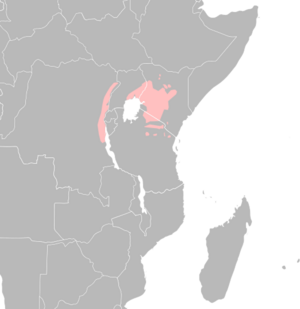Golden-winged sunbird facts for kids
Quick facts for kids Golden-winged sunbird |
|
|---|---|
 |
|
| A male in breeding plumage in Kenya feeding on Leonotis nectar | |
| Conservation status | |
| Scientific classification | |
| Genus: |
Drepanorhynchus
|
| Species: |
reichenowi
|
| Subspecies | |
|
|
 |
|
| Synonyms | |
|
|
The golden-winged sunbird (Drepanorhynchus reichenowi) is a beautiful bird. It belongs to the Nectariniidae family, which includes sunbirds. These birds are known for their bright colors and long, thin beaks.
You can find the golden-winged sunbird in parts of Africa. It lives in countries like the Democratic Republic of the Congo, Kenya, Tanzania, and Uganda.
Contents
What Does the Golden-Winged Sunbird Look Like?
Male golden-winged sunbirds are quite a bit bigger than females. A male can be about 9 inches (23 cm) long. This includes his long tail feathers. Females are smaller, around 6 inches (15 cm) long.
Both males and females have yellow edges on their wing and tail feathers. This helps you spot them! When a male is ready to breed, his body feathers turn a shiny, metallic reddish-copper color. When he's not breeding, these bright feathers are replaced by duller black ones. The male's belly is brownish-black.
Female golden-winged sunbirds are olive green on top. Their undersides are yellowish. Young birds look a lot like the females, but their bellies are a bit darker.
Where Do Golden-Winged Sunbirds Live?
These sunbirds live in parts of central and eastern Africa. They are found in the Democratic Republic of the Congo, Kenya, Tanzania, and Uganda. They prefer to live in places that are between 1,170 and 2,300 meters high.
You can find them in many different areas. They like the edges of forests and open clearings. They also live in farm areas, bamboo forests, and tall grasslands. These birds sometimes move around to find enough food.
What Do Golden-Winged Sunbirds Eat?
Golden-winged sunbirds mostly drink nectar from flowers. Their favorite food comes from the Leonotis nepetifolia plant, which is a type of mint. They also drink nectar from other flowers, especially during breeding season. Some of these include Aloe graminicola, Crotalaria species, and Erythrina abyssinica.
Besides nectar, these birds also eat insects. They catch beetles, flies, ants, bees, wasps, and different kinds of larvae.
Why Do Sunbirds Defend Their Food?
Golden-winged sunbirds often protect areas of Leonotis nepetifolia flowers. They do this outside of the breeding season in Kenya. This plant flowers in July when not many other plants are blooming.
Birds defend their territory to make sure they have enough food. It takes energy to fight off other birds, but it means they get more nectar for themselves. Studies show that by defending a territory, a sunbird can get more nectar from each flower. This means they spend less time looking for food. They can then rest more, which saves energy.
Usually, one bird defends a territory alone. Sometimes, a female might share a large territory with a male. Young birds also defend their own feeding areas. They will chase away other golden-winged sunbirds and even other types of sunbirds. Bigger birds, like the bronzy sunbird, might sometimes still get to feed in their territory.
Territory sizes can be very different, from small to quite large. But each territory usually has about the same number of flowers.
How Are Golden-Winged Sunbirds Doing?
The golden-winged sunbird lives across a very large area. Scientists have not counted their total population. However, they are not thought to be in danger. The IUCN Red List says they are of "Least Concern". This means their numbers are stable, and they are not at risk of disappearing.
Gallery



